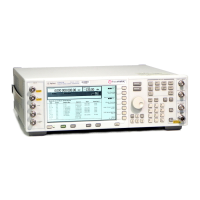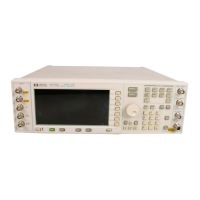120 Chapter 4
Basic Digital Operation
Understanding the I/Q Modulator Filter
Understanding the I/Q Modulator Filter
The I/Q modulator filter (I/Q Mod Filter Manual Auto softkey) lets you select either post-reconstruction low pass
filtering that has a narrower bandwidth than that of the reconstruction filter, or no post-reconstruction
filtering. It can be used with both real-time and ARB signals.
There are two modes for the I/Q modulator filter: auto or manual. With auto, the signal generator
automatically selects either filtering (2.1 MHz or 40 MHz) or no filtering depending on the signal
configuration. With manual, the user can select a 2.1 MHz filter, a 40 MHz filter, or no filter.
The low pass filter selections are fifth order elliptic filters that exhibit very low passband ripple. These filters
are positioned before the I/Q modulator, so the filtering is applied separately to the I and Q paths. Since they
are post-reconstruction filters, they do not apply any oversampling.
Because the filters are for the I and Q signals and not the modulated signal, they are filtering the I/Q
bandwidth, which has up to 40 MHz for I and 40 MHz for Q (80 MHz total I/Q bandwidth). This means that
when viewed through the RF output, the filter size appears to be twice the size of the selected filter. For
example, the 2.1 MHz I/Q bandwidth filter shows as a 4.2 MHz filter in the RF bandwidth.
The 2.1 MHz filter is for improving the ACPR on single carrier wideband signals such as W-CDMA. The
40 MHz filter is best used to eliminate spurious events. As with any filter, the I/Q modulator filters do add
some group delay. To determine whether the filters may be contributing to distortion or some unexpected
signal artifact, select the through path and view the signal. If there is no change in the signal, then the I/Q
modulator filter is not the cause.
Through Filter
2.1 MHz Filter
RF Bandwidth
larger than 4 MHz

